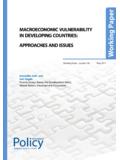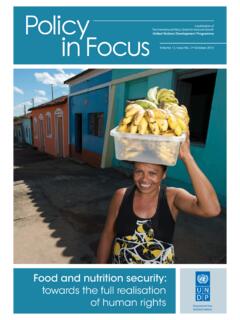Transcription of I December, 2014 The Impact of Ghana’s LEAP …
1 No. 271. The International Policy Centre for Inclusive Growth is jointly supported by ISSN 2318-9118 December, 2014. the united nations development programme and the Government of Brazil. The Impact of ghana 's LEAP programme Benjamin Davis and Silvio Daidone, Food and Agriculture Organization of the united nations ; Sudhanshu Handa and Michael Park, University of North Carolina; and Robert Osei Darko and Isaac Osei-Akoto, University of ghana ghana 's Livelihood Empowerment Against Poverty (LEAP) programme provides Beneficiaries reduced their borrowing, repaid debt more promptly and cash transfers to very poor people, particularly in households with orphans or gave gifts or credit to others.
2 Vulnerable children, the elderly and people with extreme disabilities. Beneficiaries LEAP households were considered financially reliable and thus creditworthy. also receive free national health insurance. LEAP's objectives are to alleviate The transfers had no lasting effect on consumption patterns, probably short-term poverty and to promote the development of human education, due to irregular payments. experience and abilities. The government-funded programme receives support LEAP enabled beneficiaries to spend more time working on their farms from the World Bank and the UK's Department of International development .
3 And to hire outside labour. The transfers provided capital for activities such as petty trading, and Established in 2008, by 2012 LEAP was providing cash payments of USD4 8 every two reduced the use of negative coping strategies. months to 70,000 households across ghana ; these figures, which vary according to LEAP increased the economic empowerment of some female-headed household size, are equal to about 10 per cent of baseline household consumption. beneficiary households. Payments were sometimes irregular during the period under review (May 2010 . Beneficiaries rejoined or strengthened their role in social networks, May 2012).
4 A gap in payments in 2011 was followed by a triple payment in February resulting in greater status, and self-esteem. 2012 to settle arrears. The amount of the transfers was tripled in the same year. LEAP household heads particularly women were 16 percentage The evaluation points more likely to feel happy about their lives. In 2010, baseline data were collected from 699 future LEAP beneficiaries in Impact on the local economy three regions. Propensity score matching techniques were used to construct a comparison group of 914 households coming from a nationally representative Every Ghanaian Cedi (GHS) transferred through LEAP has the potential to household survey implemented during the same year.
5 Beneficiary and raise local income by , with non-LEAP households receiving most comparison households were interviewed again after 24 months. of the indirect benefit. The largest positive effects would be on retail, with a multiplier of A local economy-wide Impact evaluation (LEWIE) model was used to simulate The estimated income multipliers reflect a context in which payments are the effect of cash transfers on the local economy in the regions included in the regular and predictable, which did not occur in this case. quantitative study. Researchers used participatory methods and in-depth case studies to gather perceptions of LEAP's Impact on household decision-making, Conclusions community dynamics and social networks.
6 Irregular and low-value payments discouraged consumption; however, the large lump-sum payment in February 2012 increased the tendency of LEAP households Impacts to save money and reduce their debt activities that strengthened community Access to health insurance and education networks and the social capital of LEAP households. About 90 per cent of the LEAP households enrolled at least one member Local economy simulations suggest that if LEAP could regularise payments, the spillover in the national health insurance system. This included a 34 per cent effects would be significant. Measures to maximise such effects should target ineligible increase among children under six years old, and a 16 per cent increase households, which provide many goods and services in the local economy.
7 Among children from six to 17 years old. The programme slightly increased preventive care for children. Three issues arose from the Impact evaluation. First was the low value of the cash LEAP households were more likely to report sickness in young children, transfer, which was resolved by tripling the payment amount in January 2012. although they were less likely to report sickness among older children. Second were the irregular payments, which did not allow households to improve The transfer enabled household members to pay for ongoing permanent consumption or effectively manage risk. The third issue concerned prescription medicines for the elderly and infirm.
8 The lack of synergies with other social programmes, including health services and LEAP increased school enrolment among secondary school children by programmes for sustainable livelihoods. Greater support for social programmes at 7 percentage points and reduced grade repetition by children of primary the community level has the potential to considerably improve LEAP's impacts. and secondary school age. Among primary school children, References: LEAP reduced absenteeism by 10 percentage points. The increase in Handa, S., M. Park, R. Darko, I. Osei-Akoto, B. Davis and S. Daidone (2013). Livelihood Empowerment against secondary school enrolment was limited to boys, while the increase Poverty Impact Evaluation.
9 Chapel Hill, NC, Carolina Population Center, University of North Carolina. in attendance was more pronounced for girls. Oxford Policy Management (2013). Qualitative Research and Analyses of the Economic Impact of Cash Transfer Programmes in sub-Saharan Africa. ghana Country Case Study Report, PtoP project report. Rome, Beneficiaries perceived that child labour shrank as enrolment and school Food and Agriculture Organization of the united nations . retention increased. Thome, K., E. Taylor, J. Kagin, B. Davis, R. Darko, I. Osei-Akoto and S. Handa (2013). Local Economy-wide Impact Evaluation (LEWIE) of ghana 's Livelihood Empowerment Against Poverty (LEAP) programme .
10 PtoP. Savings, debt reduction and social networks project report. Rome, Food and Agriculture Organization of the united nations . For more information, contact the PtoP team at or visit the website LEAP beneficiaries were nearly 11 per cent more likely to save money. < >. International Policy Centre for Inclusive Growth (IPC - IG). united nations development programme The views expressed in this page are the authors' and not SBS, Quadra 1, Bloco J, Ed. BNDES, 13 andar E-mail: URL: necessarily those of the united nations development 70076-900 Brasilia, DF - Brazil Telephone: +55 61 2105 5000 programme or the Government of Brazil.









